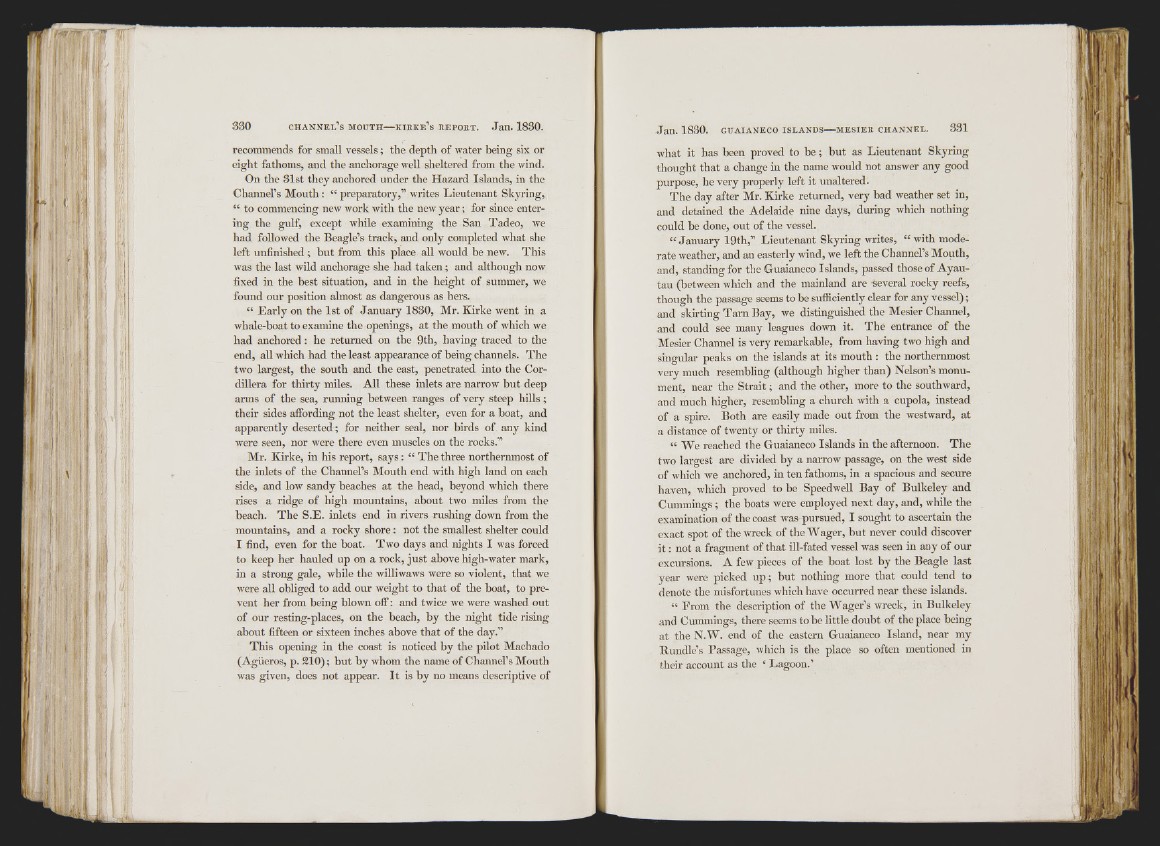
h' il
1' I '
i l f
recommends for small vessels; the depth of water being six or
eight fathoms, and the anchorage well sheltered from the wind.
On the 31st they anchored under the Hazard Islands, in the
Channel’s Mouth : “ preparatory,’’ writes Lieutenant Skyring,
“ to commencing new work with the new year; for since entering
the gulf, except while examining the San Tadeo, we
had followed the Beagle’s track, and only completed what she
left unfinished ; but from this place all would be new. This
was the last wild anchorage she had taken; and although now
fixed in the best situation, and in the height of summer, we
found our position almost as dangerous as hers.
“ Early on the 1st of January 1830, Mr. Kirke went in a
whale-boat to examine the openings, at the mouth of which we
had anchored : he returned on the 9th, having traced to the
end, all which had the least appearance of being channels. The
two largest, the south and the east, penetrated into the Cordillera
for thirty miles. All these inlets are narrow but deep
arms of the sea, running between ranges of very steep hills;
their sides affording not the least shelter, even for a boat, and
apparently deserted; for neither seal, nor birds of any kind
were seen, nor were there even muscles on the rocks.’’
Mr. Kirke, in his report, says: “ The three northernmost of
the inlets of the Channel’s Mouth end with high land on each
side, and low sandy beaches at the head, beyond which there
rises a ridge of high mountains, about two miles from the
beach. The S.E. inlets end in rivers rushing down from the
mountains, and a rocky shore: not the smallest shelter could
I find, even for the boat. Two days and nights I was forced
to keep her hauled up on a rock, just above high-water mark,
in a strong gale, while the williwaws were so violent, that we
were all obliged to add our weight to that of the boat, to prevent
her from being blown off: and twice we were washed out
of our resting-places, on the beach, by the night tide rising
about fifteen or sixteen inches above that of the day.’’
This opening in the coast is noticed by the pilot Machado
(Agüeros, p. 210); but by whom the name of Channel’s Mouth
was given, does not appear. It is by no means descriptive of
what it has been proved to b e ; but as Lieutenant Skyring
thought that a change in the name would not answer any good
purpose, he very properly left it unaltered.
The day after Mr. Kirke returned, very bad weather set in,
and detained the Adelaide nine days, during which nothing
could be done, out of the vessel.
“ January 19th,’’ Lieutenant Skyring writes, “ with moderate
weather, and an easterly wind, we left the Channel’s Mouth,
and, standing for the Guaianeco Islands, passed those of Ayau-
tau (between which and the mainland are several rocky reefs,
though the passage seems to be sufficiently clear for any vessel);
and skirting Tam Bay, we distinguished the Mesier Channel,
and could see many leagues down it. The entrance of the
Mesier Channel is very remarkable, from having two high and
singular peaks on the islands at its mouth : the northernmost
very much resembling (although higher than) Nelson’s monument,
near the Strait; and the other, more to the southward,
and much higher, resembling a church with a cupola, instead
of a spire. Both are easily made out from the westward, at
a distance of twenty or thirty miles.
“ We reached the Guaianeco Islands in the afternoon. The
two largest are divided by a narrow passage, on the west side
of which we anchored, in ten fathoms, in a spacious and secure
haven, which proved to be Speedwell Bay of Bulkeley and
Cummings ; the boats were employed next day, and, while the
examination of the coast was pursued, I sought to ascertain the
exact spot of the wreck of theAVager, but never could discover
i t : not a fragment of that ill-fated vessel was seen in any of our
excursions. A few pieces of the boat lost by the Beagle last
year were picked u p ; but nothing more that could tend to
denote the misfortunes which have occurred near these islands.
“ From the description of the Wager’s wreck, in Bulkeley
and Cummings, there seems to be little doubt of the place being
at the N.W. end of the eastern Guaianeco Island, near my
Bundle’s Passage, which is the place so often mentioned in
their account as the ‘ Lagoon.’